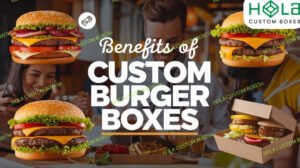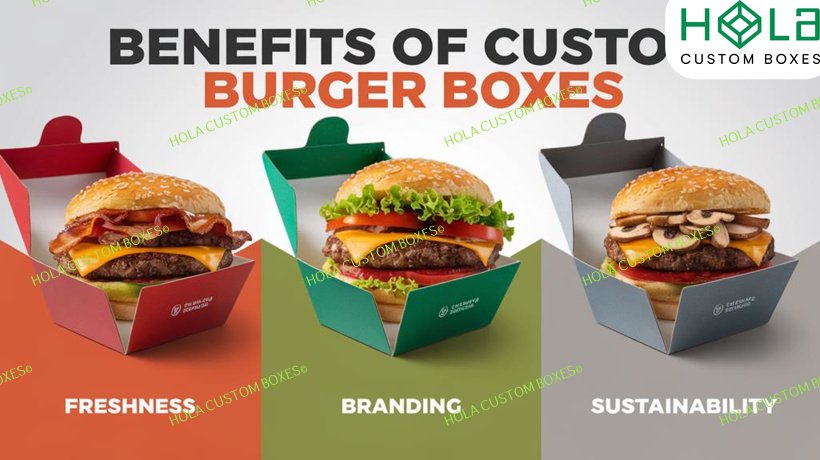The prices of burger packaging boxes are influenced by several key factors. Material selection markedly affects both cost and consumer perception, with options ranging from economical cardboard to premium materials. Dimensions and design choices impact production efficiency and durability. The fragility of the product necessitates specialized protective measures, while printing and finishing techniques can vary widely in expense based on complexity. Moreover, add-ons enhance presentation but can inflate costs. Finally, order volume plays a critical role, where larger quantities reduce per-unit expenses through economies of scale. Understanding these factors is essential for effective cost management and strategic sourcing. Exploring further reveals further insights into this topic.
Main Points
- Material choice impacts costs; cardboard and Kraft paper are cost-effective, while premium materials elevate brand perception and expenses.
- Custom dimensions reduce waste and damage; one-size-fits-all designs can lead to higher costs and compromised packaging integrity.
- Fragility of the product dictates packaging needs; fragile items may require specialized solutions, increasing overall packaging costs.
- Printing methods affect pricing; traditional methods are economical for bulk runs, while digital printing offers flexibility at a higher cost per unit.
- Order volumes significantly influence pricing; larger orders lower per-unit costs through economies of scale, while smaller runs raise expenses.
Burger Box Material Selection
Material selection is a critical determinant of packaging box prices, influencing both manufacturing costs and consumer perceptions. The choice of materials directly impacts packaging costs, with cardboard burger boxes striking a balance between durability and affordability.
Commonly utilized materials such as Kraft paper not only offer cost-effectiveness but also align with the growing demand for eco-friendly packaging options. In contrast, more premium materials like organic or naturally derived substances may elevate production expenses but cater to environmentally conscious consumers, thereby enhancing brand perception.
The strength and versatility of Bux boards further demonstrate the importance of material selection, as these high-quality materials can provide superior structural integrity. However, the availability of specific materials can limit customization options, affecting the overall feasibility and cost of production.
Brands must navigate the trade-off between premium material choices and budget constraints, as selecting high-quality materials can enhance consumer trust and brand loyalty.
In the end, a thorough analysis of material selection is essential for optimizing packaging costs while achieving sustainable packaging goals, ensuring that the final product resonates with target audiences and aligns with market trends.
Burger Box Dimensions and Design

When considering burger packaging box prices, dimensions and design play a fundamental role in determining overall costs and functionality. The size of burger boxes markedly influences packaging costs; accurately measured custom dimensions prevent unnecessary expenses associated with excess material and potential product damage. In contrast, one-size-fits-all designs can lead to higher costs and compromise product integrity.
The complexity of packaging design is another vital factor. Unique shapes and intricate structures can raise production expenses, impacting the overall pricing of burger boxes. Furthermore, vibrant colors and advanced printing techniques enhance brand visibility but contribute to increased printing expenses.
Labeling is essential for consumer transparency and regulatory compliance. Incorporating clear ingredient and nutritional information into the design can add to overall costs, yet it is a necessary expense to build trust with consumers.
| Factor | Impact on Costs |
| Custom Dimensions | Reduces excess material costs |
| One-Size-Fits-All | Increases risk and expenses |
| Design Complexity | Raises production costs |
| Vibrant Colors | Increases printing expenses |
Product Fragility Of Custom Burger Boxes
The fragility of burger products necessitates careful consideration in packaging design, as delicate items require enhanced protective measures to assure safe delivery and maintain quality. Packaging costs are notably impacted by the need for specialized solutions to safeguard fragile items. For instance, custom inserts that bolster stacking strength and durability are often essential, yet they can increase overall packaging expenses.
Furthermore, the integration of moisture-resistant films is vital for protecting fragile food products from environmental factors, but this also contributes to heightened costs. In contrast, non-fragile items can often utilize simpler packaging designs, allowing for cost savings compared to those requiring reinforced solutions.
A vital aspect of packaging design is balancing protection needs with budget constraints. While it may be tempting to incorporate advanced protective measures, over-specification for fragile items can lead to unnecessary expenses that affect overall profitability.
Consequently, identifying the appropriate level of protection, without compromising quality or exceeding budget limits, is essential for optimizing packaging strategies for burger products.
Printing and Finishing Of Burger Packaging
Effective packaging not only protects fragile burger products but also serves as an essential medium for branding through printing and finishing techniques. The complexity of the graphics plays a considerable role in determining printing costs; simple designs are generally more cost-effective compared to intricate, high-resolution prints, which can greatly increase production expenses.
Traditional printing methods, such as offset and flexography, are typically more economical for large runs, while modern digital printing offers flexibility, albeit at a higher cost per unit.
Finishing techniques, including embossing and foil stamping, enhance the visual appeal of burger packaging but contribute to overall costs due to the specialized skills and equipment required. The choice of materials and inks is equally important; while eco-friendly inks may raise costs, they can considerably enhance brand image and cater to environmentally conscious consumers.
Ultimately, consistency in branding through well-designed packaging not only boosts brand recognition but also justifies higher initial printing costs by potentially driving long-term sales and fostering customer loyalty.
Therefore, the interplay between printing, finishing, and their associated costs is essential in determining the overall effectiveness and marketability of burger packaging.
Add-ons and Accessories Of Burger Boxes
Incorporating add-ons and accessories into burger packaging can greatly elevate the consumer experience while also impacting the overall cost structure. Vital accessories such as branded tissue paper and void fills enhance product presentation and protection but contribute to increased packaging costs, necessitating careful financial management.
Moreover, the inclusion of items like custom inserts and tape can improve product protection, yet they often harbor hidden costs that can strain the packaging budget.
It is important to highlight that effective design can mitigate the need for excessive protective materials, eventually lowering expenses associated with add-ons.
Collaboration with suppliers to identify necessary accessories allows for a streamlined cost approach, avoiding modifications that could inflate the overall price of burger packaging.
Balancing premium add-ons with budget constraints is essential, as excessive customization may lead to higher production costs without a corresponding increase in perceived value.
Order Volumes Of Custom Burger Boxes
In relation to burger packaging, order volumes play an essential role in determining overall pricing structures. Higher order volumes typically enable businesses to engage in bulk purchases, which result in markedly lower per-unit costs due to economies of scale.
For example, ordering 10,000 custom burger boxes can yield a drastically reduced price per box in contrast to a smaller order of 1,000. This price reduction occurs as fixed costs, including setup and tooling, are distributed across a greater number of units, thereby lowering the overall expense.
Conversely, smaller order quantities often result in higher per-unit costs, primarily due to the inefficiencies linked with production runs and the necessity for frequent setup changes. Such inefficiencies can erode potential savings, making it imperative for companies to strategically plan their order volumes.
